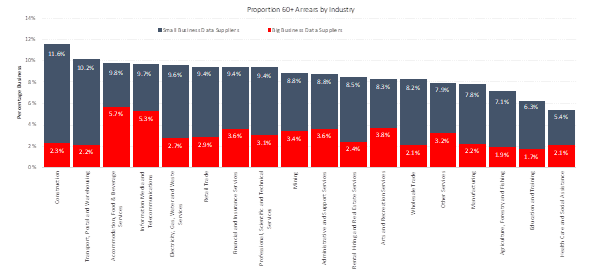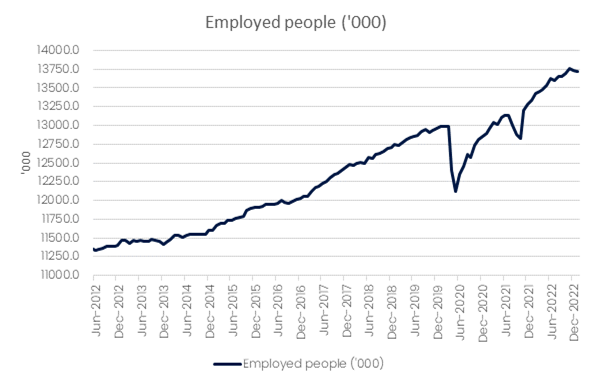During the reporting season, valuable insights were gained into Australian businesses’ outlook on the stock exchange.
While the majority of retailers reported strong earnings in the second half of 2022, their sales projections for the upcoming year were more subdued. Several companies downgraded their sales projections for various categories and emphasised caution.
“Groups like Adairs, JB HiFi and Baby Bunting all highlighted that sales in the year ahead in many categories are likely to be lower. This year we will see the impact of many more consumers having less to spend each month, as up to 800,000 fixed-rate loans on very low-interest rates will convert to variable-rate loans.
“We will also see the added impact of housing completions begin to trend down from about the middle of the year. This will affect sales in the furniture, white goods, and electrical goods categories,” Anneke Thompson, Chief Economist, CreditorWatch, said.
In the year ahead, retailers are expected to face challenges as many consumers will have less disposable income due to up to 800,000 fixed-rate loans converting to variable-rate loans, resulting in higher interest rates and reduced spending power. Furthermore, the furniture, white goods, and electrical goods categories are likely to be affected by a decline in housing completions from mid-year onwards.
These factors are expected to create headwinds for retailers, negatively impacting their sales and revenue. However, businesses that can adapt to the changing economic landscape and consumer behaviour may be able to thrive despite these challenges.
Delayed payment times

Small businesses continue to face challenges with late payments, with the average late payment rate for January being three times higher for small businesses compared to large businesses. This disparity highlights the difficulties faced by small businesses in enforcing payment terms and collecting overdue payments, as well as the tendency of some larger businesses to treat smaller suppliers as a source of interest-free credit.
Although payment arrears have been slowly decreasing across all industries, the construction industry continues to face significant challenges due to inherent payment structures that involve delayed payments for projects.
In January, 11.6 per cent of small construction businesses reported payments that were 60 days or more in arrears, compared to just 2.3 per cent of large businesses.
The problem of late payments can have severe consequences for small businesses, impacting their cash flow and ability to pay suppliers and employees on time. The Australian government has taken steps to address this issue with the introduction of the Payment Times Reporting Scheme in 2020, which requires large businesses to report their payment times to small business suppliers.
This initiative aims to improve transparency and accountability in payment practices, ultimately reducing the impact of late payments on small businesses.
Higher insolvency risk
Moreover, the Business Risk Index continues to indicate a higher risk of insolvency for sectors that rely on discretionary spending. According to the index, the food and beverage sector is the riskiest, with a 7.3 per cent probability of default.
This is further supported by a recent survey conducted by Finder, which revealed that a majority of respondents were cutting back on their expenses, particularly in the category of ‘dining and drinking out’ (51 per cent). The survey also showed that over a third of respondents (36 per cent) had limited their attendance at events such as movies, sporting games, and concerts.
This highlights the significant risk faced by the food and beverage sector, as businesses must now contend with high costs, including wages, interest payments, and rents, along with lower demand. This situation is likely to create a challenging environment for business owners in this sector, making it essential to adopt measures to mitigate these risks and ensure business continuity.
Inflation – a big concern
The world is closely monitoring inflation as it continues to be a key metric of concern. While some economists suggest that inflation may have peaked in Australia during the December 2022 quarter, when it hit 7.8 per cent, it still remains significantly higher than the Reserve Bank of Australia’s target rate of 2-3 per cent.
In fact, experts predict that inflation may not return to the desired levels until as late as 2025. Other economies are also grappling with high inflation levels, which have yet to normalise.
This persistent inflation is attributed to several supply-side factors, such as the ongoing Ukraine War and unfavourable weather conditions affecting crop harvests. These factors are beyond central banks’ control, adding to the challenge of managing inflation.
The impact of high inflation is significant, as it reduces consumers’ purchasing power and puts a strain on household budgets. Additionally, it affects business operations and investments, leading to higher costs and potentially lower profits.
Job market is showing signs of cautiousness

According to the ABS, the seasonally adjusted unemployment rate increased from 3.5 per cent to 3.7 per cent in January 2023. Although there are still almost 400,000 more employed people in Australia compared to January 2022, it is unlikely that the strong employment gains of 2022 will be repeated this year. The ABS has reported a decline in employment for the past two months, indicating that employers may have peaked in November 2021.
Businesses are expected to be more cautious in hiring, but there have been no reports of mass redundancy announcements yet. While an increase in unemployment is not great news for job seekers, it can be beneficial for the economy as it reduces the risk of wage-price spirals.
In January 2023, retail trade data showed a seasonally adjusted increase of 1.9 per cent compared to the previous month, following a large decline of 4 per cent in December. The total dollar value of retail trade in January 2023 was similar to that of September 2022. However, household goods retailing saw a significant drop in trade, with levels well below those of 2022 and trading at or near the level of October 2021.
CreditorWatch is a digital credit reporting agency, headquartered in Sydney


